Product Overview
Lipo-B (MIC) injection is a compounded formulation that contains methionine, choline, and cyanocobalamin (vitamin B₁₂).
These ingredients are considered lipotropic agents, or “fat-burning” nutrients, which may support the metabolism of fat.
Lipo-B injections are typically used as a supplemental aid to weight loss, intended to complement a healthy diet and exercise regimen.[1][2]
Administration: Lipo-B comes as an injectable solution to be given intramuscularly (into a muscle). In a clinical or home setting (with proper guidance), it is often injected in areas such as the upper arm, thigh, hip, or buttock.[22] Each 1 mL of Lipo-B injection typically contains approximately 25 mg of methionine, 50 mg of choline chloride, and 1 mg of cyanocobalamin (vitamin B₁₂), provided in multi-dose vials by compounding pharmacies.[15] The intramuscular route bypasses the digestive system, allowing the nutrients to be absorbed directly.
Frequency: The dosing schedule for Lipo-B injections can vary based on individual needs and physician recommendations. In many weight loss programs, patients receive a Lipo-B injection about once a week for optimal results.[23] Most practitioners find that weekly injections help maintain consistent levels of the lipotropic factors.
In some cases, healthcare providers may adjust the frequency, for example, some patients might be advised to take the injection twice weekly or once every two weeks, depending on their specific goals and how they respond to treatment.[23]
The duration of therapy (number of weeks or months of injections) is also determined on a case-by-case basis. It’s important that a qualified healthcare provider establish the dosage regimen and monitor progress, adjusting the plan as necessary to ensure both safety and effectiveness.
Lipo-B injections work by potentially enhancing the body’s fat-burning processes through their key ingredients.
Methionine and choline play vital roles in fat metabolism: they help the liver break down fats more efficiently and prevent accumulation of fat in the liver.[3]
By promoting the release and transport of stored fat, these lipotropic nutrients make it easier for the body to utilize fat as an energy source.[3]
Additionally, cyanocobalamin (vitamin B₁₂) in the Lipo-B injection may help boost energy production and may support a higher metabolic rate, which can further aid in burning calories and fat.[4]
Together, this combination of amino acids and B₁₂ vitamin may synergistically enhances fat mobilization and utilization by the body.[3][4]
There are certain clinical conditions under which Lipo-B injections should be avoided or used only with extreme caution.
Individuals with a known hypersensitivity or allergy to vitamin B₁₂ (cobalamin) or any other component of the injection must not use Lipo-B, as allergic reactions could be severe.[5]
Patients with metabolic acidosis or severe liver disease should also avoid Lipo-B injections; methionine, one of the key ingredients, may aggravate metabolic acidosis and a compromised liver may be unable to properly metabolize the compounds.[6]
Furthermore, Lipo-B is contraindicated in people with Leber’s hereditary optic neuropathy (Leber’s disease); cyanocobalamin has been reported to precipitate rapid optic nerve damage in individuals with this rare condition.[7]
Lipo-B injection’s components (particularly vitamin B₁₂) have relatively few serious drug interactions, but it is still important to consider potential interactions.
For example, the antibiotic chloramphenicol can interfere with the effects of vitamin B₁₂, reducing the expected hematologic response to B₁₂ therapy.[8]
In addition, drugs that affect blood cell production, such as certain chemotherapy agents or some HIV medications, may blunt the benefits of vitamin B₁₂ or alter blood counts.[9]
While methionine and choline do not have well-known dangerous interactions, it is essential to inform your healthcare provider of all medications, supplements, or herbal products you are taking before starting Lipo-B injections. This precaution helps prevent any unforeseen interactions and ensures safe use of the injection alongside other treatments.[10]
Lipo-B (MIC) injections are generally well tolerated in most individuals. However, as with any supplement or medication, some side effects can occur.
Mild gastrointestinal symptoms have been reported in some cases; for instance, a few people experience nausea, upset stomach, or diarrhea after the injection. Others might notice transient dizziness or light-headedness shortly following an injection.[11]
Injection site reactions are also possible; these can include pain, redness, or swelling at the site of the shot, which typically resolve on their own. In rare instances, repeated injections of certain lipotropic components have led to inflammation or small nodules forming under the skin at the injection site.[12]
Serious adverse reactions to Lipo-B injections are uncommon. Allergic reactions are possible, though infrequent; signs of an allergy may include rash, hives, itching, or even anaphylaxis (a severe allergic response) in highly sensitive individuals.[13]
There have also been rare reports of high-dose vitamin B₁₂ (as in injectable form) precipitating skin outbreaks such as acne or rosacea in susceptible persons.[13]
Overall, for the majority of users the side effects are mild and temporary, but anyone experiencing persistent or severe symptoms should seek medical attention.[11][13]
Lipo-B injections are not recommended for use during pregnancy. There is insufficient clinical research to establish the safety or efficacy of these injections in pregnant women, so avoiding them is advised to prevent any possible risk to the developing fetus.[14]
Similarly, women who are breastfeeding should refrain from using Lipo-B injections. It is not known whether the components of Lipo-B (particularly vitamin B₁₂ or amino acids in high doses) could affect a nursing infant, and therefore the safest course is to avoid such injections while breastfeeding.[14]
Healthcare professionals generally counsel pregnant or nursing mothers to instead rely on prenatal vitamins or physician-supervised nutrition plans rather than lipotropic injections in order to protect the baby.[14]
Store Lipo-B injection vials at controlled room temperature, ideally around 68°-77°F (20°-25°C).[18]
Keep the medication in a cool, dry place, away from direct heat, moisture, and light. Do not freeze the solution. As with all medications, store it out of reach of children.
If any medication remains unused beyond the recommended beyond-use or expiration date, it should be disposed of properly; do not pour unused solution down the drain or flush it.[18]
Follow any disposal instructions on the label or given by the pharmacy, or return the unused medication to a take-back program if available.
- North Texas Integrated Healthcare. (n.d.). Lipo B12 - Lipotropic MIC injection for weight loss. Retrieved from https://northtexasintegratedhealthcare.com/b12-injections
- Cherney, K. (2024, November 14). Lipotropic injections: Benefits, side effects, dosage, and cost. Healthline. Retrieved from https://www.healthline.com/health/lipotropic-injections
- RVA Revive. (2023). The power of lipotropic injection therapy. Retrieved from https://rvarevive.com/learn-more/blog/the-power-of-lipotropic-injection-therapy
- Liberoni, D. (n.d.). Lipotropic (MIC) B12 injections for weight loss - What are MIC injections and how do they work? DoctorLiberoni Weight Loss Clinic. Retrieved from https://www.doctorliberoni.com/weight-loss (Archived content)
- RxList. (2021). Vitamin B12 (Cyanocobalamin) - Warnings and contraindications. RxList. Retrieved from https://www.rxlist.com/cyanocobalamin
- Pediatric Oncall. (n.d.). Methionine - Mechanism, Indications, Contraindications, Dosing, Adverse Effects. Pediatric Oncall Drug Index. Retrieved from https://www.pediatriconcall.com/drugs/methionine
- Drugs..com. (n.d.). B-12 (cyanocobalamin) - Disease Interactions. Retrieved from https://www.drugs.com/disease-interactions/cyanocobalamin,b-12.html
- Drugs..com. (n.d.). Drug interaction report: Chloramphenicol and Vitamin B12. Retrieved from https://www.drugs.com/drug-interactions/chloramphenicol-with-vitamin-b12-579-0-754-3756.html
- RxList. (2021). Cyanocobalamin - Drug interactions and precautions. RxList. Retrieved from https://www.rxlist.com/cyanocobalamin-drug.htm
- Caporuscio, J. (2023, April 17). Lipotropic injections: Cost, dosage, and risks. Medical News Today. Retrieved from https://www.medicalnewstoday.com/articles/lipotropic-injections
- Empower Pharmacy. (n.d.). Lipo-B Injection - Adverse Reactions/Side Effects. Empower Pharmacy [Product Monograph]. Retrieved from https://www.empowerpharmacy.com/compounding-pharmacy/lipo-b-injection
- Cherney, K. (2024, November 14). Lipotropic injections: Benefits, side effects, dosage, and cost (Injection site reactions excerpt). Healthline. Retrieved from https://www.healthline.com/health/lipotropic-injections#side-effects
- Vasavada, A., & Sanghavi, D. (2023). Cyanocobalamin (Vitamin B12). In StatPearls [Internet]. StatPearls Publishing. Retrieved from https://www.ncbi.nlm.nih.gov/books/NBK555964/
- Eden Integrative Medicine. (2023). Lipo-B injections - Contraindications in pregnancy and breastfeeding. TryEden Health Blog. Retrieved from https://www.tryeden.com/post/lipo-b-injections
- Empower Pharmacy. (n.d.). Lipo-B Injection - Dosage Strengths (25/50/1 mg/mL). Empower Pharmacy [Product Catalog]. Retrieved from https://www.empowerpharmacy.com/compounding-pharmacy/lipo-b-injection
- Z Med Clinic. (n.d.). Lipo-B Injections - Weight loss benefits and usage. Z Med Clinic & Med Spa (Houston). Retrieved from https://www.zmedclinic.com/services/lipo-b-injections-cyfair
- Rise Men’s Health. (2021). 12 Medical Benefits of Lipo-B Injections. Rise Mens Health Blog. Retrieved from https://risemenshealth.com/12-benefits-of-lipo-b-weight-loss-support-backed-by-medical-care/
- Empower Pharmacy. (n.d.). Lipo-B Injection - Storage and handling. Empower Pharmacy. Retrieved from https://www.empowerpharmacy.com/compounding-pharmacy/lipo-b-injection
- North Texas Integrated Healthcare. (n.d.). Lipo B12 (MIC) injection for fat loss. Retrieved from https://northtexasintegratedhealthcare.com/b12-injections
- Cherney, K. (2024, November 14). Lipotropic injections: Benefits, side effects, dosage, and cost (Usage context). Healthline. Retrieved from https://www.healthline.com/health/lipotropic-injections
- Z Med Clinic. (n.d.). Why choose Lipo-B injections for weight loss? Z Med Clinic & MedSpa. Retrieved from https://www.zmedclinic.com/services/lipo-b-injections-cyfair
- New Horizons Med Spa. (2019). Methionine Inositol Choline (MIC) Injections for Weight Loss - Treatment Overview. New Horizons Med Spa (Chandler, AZ). Retrieved from https://newhorizonsmedspa.com/methionine-inositol-choline-mic-injections-for-weight-loss/
- The Body Shop IV. (n.d.). Lipo-B IM Injection - FAQ. The Body Shop IV Infusion Therapy. Retrieved from https://www.thebodyshopiv.com/services/lipo-b-im-injection
- Empower Pharmacy. (2025). Compounding Pharmacy FAQs - Prescription Requirements. Empower Pharmacy. Retrieved from https://www.empowerpharmacy.com/faq (licensed in all 50 states)
- Bean, M. (2024, December 2). Diabetes group recommends against compounded GLP-1s. Becker’s Hospital Review. Retrieved from https://www.beckershospitalreview.com/pharmacy/diabetes-group-recommends-against-compounded-glp-1s
- RxList. (2021). Cyanocobalamin (Vitamin B12) - Contraindications. RxList. Retrieved from https://www.rxlist.com/cyanocobalamin
- Pediatric Oncall. (n.d.). Methionine - Contraindications. Pediatric Oncall Drug Database. Retrieved from https://www.pediatriconcall.com/drugs/methionine
- Drugs..com. (n.d.). B-12 - contraindicated in Leber’s disease (optic atrophy). Drugs.com. Retrieved from https://www.drugs.com/disease-interactions/cyanocobalamin,b-12.html
- RVA Revive. (2023). Lipotropic injections and pregnancy/breastfeeding (Precautions). RVA Revive Blog. Retrieved from https://rvarevive.com/learn-more/blog/the-power-of-lipotropic-injection-therapy
- Millennium Physicians. (n.d.). Lipotropic Injections - Side Effects. Millennium Physicians Weight Loss Center. Retrieved from https://millenniumphysicians.com/lipotropic-injections/
- HydraMed. (2023). Lipo MIC Plus Injections - Safety and tolerability. HydraMed Blog. Retrieved from https://hydramed.com/blog/the-ultimate-guide-to-lipo-c-injections-benefits-side-effects-and-more
- Z Med Clinic. (n.d.). Lipo-B Injections - Patient FAQ (When will I see results?). Z Med Clinic & Med Spa. Retrieved from https://www.zmedclinic.com/services/lipo-b-injections-cyfair
- Caporuscio, J. (2023, April 17). Lipotropic injections: Cost, dosage, and risks (Lifestyle importance). Medical News Today. Retrieved from https://www.medicalnewstoday.com/articles/lipotropic-injections
What is Lipo-B injection and what is it used for?
Lipo-B injection is a compounded lipotropic injection containing methionine, choline, and vitamin B₁₂. It is used as an adjunct for weight loss and fat-burning.
The injection is intended to help accelerate the breakdown of fat in the body and is typically recommended as part of an overall weight management plan alongside diet and exercise.[19][20]
In practice, Lipo-B injections may help boost energy and metabolism in individuals who are trying to lose weight, thereby supporting their weight loss efforts when combined with healthy lifestyle changes.[20]
How does Lipo-B injection aid in weight loss?
Lipo-B injections aid in weight loss by speeding up the metabolism of fat and supporting the body’s fat-burning processes.[21]
The amino acids methionine and choline in the injection help the liver process and remove excess fat more efficiently, essentially “releasing” stored fat so that it can be burned for energy.
Meanwhile, the vitamin B₁₂ component helps increase energy levels and may improve overall metabolic function, which can enhance calorie burning.
In simple terms, Lipo-B provides nutrients that help break down fat deposits and convert fat into usable energy, giving an extra fat-loss boost when combined with diet and exercise.[21]
How is Lipo-B injection administered, and how often do I take it?
Lipo-B injections are administered intramuscularly, meaning the shot is given directly into a muscle (commonly in the deltoid of the upper arm, the thigh, hip, or buttock).[22]
The injections are usually given in a clinic setting, but in some cases patients may be taught to self-administer at home under medical guidance.
As for frequency, most patients receive Lipo-B injections about once a week for best results.[23]
Your healthcare provider will determine the appropriate dosage and frequency for you; some protocols may use twice-weekly injections or injections every other week, depending on your individual needs and how you respond to therapy.[23]
It’s important to follow the schedule provided by your provider and not to exceed the recommended dose or frequency.
Do I need a prescription for Lipo-B injection?
Yes, you do. Lipo-B injection is a compounded medication, which means it is custom-prepared by a compounding pharmacy and dispensed for individual patients.
Such compounded products are only available with a valid prescription from a licensed healthcare provider.[24]
You will need to consult with a physician or qualified prescriber who can evaluate your health status and determine if Lipo-B injections are appropriate for you, and then write a prescription.
Are Lipo-B injections FDA-approved?
No, Lipo-B injections (and similar lipotropic injection formulas) are not FDA-approved. Compounded products do not undergo the FDA’s formal review process for safety, quality, or efficacy.[25]
The individual ingredients in Lipo-B (such as vitamin B₁₂) might themselves be FDA-approved for certain medical uses, but the specific combination and use of these ingredients for weight loss is not an FDA-approved therapy.
Because they are compounded, Lipo-B injections are provided based on a doctor’s judgment and pharmacy compounding standards rather than FDA approval.
It’s important to obtain such injections from a reputable, licensed pharmacy to ensure proper quality and sterility.
Who should not use Lipo-B injections?
People with certain conditions should avoid Lipo-B injections. You should not use Lipo-B if you have an allergy to any of its components, particularly to cobalt or vitamin B₁₂ (cyanocobalamin), as this could cause serious allergic reactions (e.g. hives, difficulty breathing).[26]
Individuals with severe liver disease or with a condition called metabolic acidosis are also contraindicated for Lipo-B; the methionine in the injection can worsen acidosis and a impaired liver may not properly handle the ingredients.[27]
Additionally, anyone with Leber’s hereditary optic neuropathy (a rare inherited eye disease) must avoid cyanocobalamin injections, since B₁₂ can precipitate rapid worsening of that condition.[28]
Pregnant and breastfeeding women are generally advised not to use Lipo-B injections as well (see above discussion in “Pregnancy” section).
If you have any chronic medical conditions (such as heart disease or epilepsy, for example), or are on long-term medications, consult your healthcare provider to determine if Lipo-B is safe for you before starting.
Can I use Lipo-B injections if I am pregnant or breastfeeding?
In most cases, no. Lipo-B injections are not recommended during pregnancy or while breastfeeding.[14]
There is not enough data to guarantee safety for the fetus or nursing infant. During pregnancy, it’s crucial to avoid unnecessary substances that could pose a risk to the baby, and currently there have been no well-controlled studies to establish that lipotropic injections are safe in pregnant women.
Similarly, for breastfeeding mothers, it’s unknown if the compounds in Lipo-B might be passed to the infant through breast milk, so doctors advise against using them.
If you are pregnant or nursing and concerned about nutrient levels or weight management, talk to your doctor about safer alternatives (such as prenatal vitamins, B₁₂ in oral form, or other interventions) rather than using Lipo-B injections.[14]
Are there any side effects of Lipo-B injections?
Yes, there can be side effects, although they are typically mild for most people.
Some individuals experience stomach upset after a Lipo-B injection; for example, mild nausea or even mild diarrhea can occur in response to the sudden influx of nutrients.[30]
You might also encounter headache or feel a bit lightheaded shortly after the injection, but these effects are usually transient.[30]
At the injection site, it’s possible to have some redness, swelling, or irritation; proper injection technique and site rotation can minimize these local reactions, and they tend to resolve quickly on their own.[30]
Serious side effects are rare. Allergic reactions are uncommon, but if you were to experience symptoms like swelling of the tongue or throat, hives, or difficulty breathing after an injection, that could indicate an allergy and you should seek medical help immediately.[30]
Overall, Lipo-B injections are well-tolerated in the majority of users, and any minor side effects that do arise usually pass without intervention.
How quickly will I see results from Lipo-B injections?
Results can vary widely from person to person. Some people notice certain effects within days; for instance, an increase in energy or improvement in mood can often be felt in the first week or two, thanks to the vitamin B₁₂ in the injection.[32]
When it comes to weight loss or fat reduction, it’s a more gradual process. Remember that Lipo-B injections are an aid to weight loss, not an instant fix.
Typically, if Lipo-B is going to contribute to your results, you might start seeing changes over several weeks of consistent use in combination with diet and exercise. Many patients report that after about 4 weeks of weekly injections, they observe improvements such as more steady energy levels and easier weight loss progress.
The degree of weight loss will depend on your diet, activity level, and individual metabolism. It’s important to maintain realistic expectations; Lipo-B injections can help make weight loss efforts more effective, but noticeable fat loss will still require a few weeks of sustained healthy habits.[32]
Always track your progress with your healthcare provider to evaluate how well the injections are working for you.
Do I still need to diet and exercise while using Lipo-B injections?
Yes. It is crucial to continue following a healthy diet and exercise routine while using Lipo-B injections.
Lipotropic injections are not a substitute for proper nutrition and physical activity. Their purpose is to enhance fat metabolism and boost your energy, but they work best in conjunction with lifestyle changes.
Experts emphasize that one cannot rely on injections alone to lose fat; you must maintain healthy eating habits and regular exercise to achieve and sustain weight loss.[33]
In fact, the injections are intended to “complement” your weight loss regimen, meaning they give you an extra edge (such as helping overcome plateaus or low energy) only if you are also controlling your calorie intake and staying active.
By eating a balanced, reduced-calorie diet and exercising consistently, you create the calorie deficit needed for weight loss; Lipo-B injections may then accelerate the fat-burning within that framework.
Without diet and exercise, any effect of the injection would be minimal. So, for best results, think of Lipo-B as one component of a comprehensive weight management strategy that fundamentally depends on a healthy lifestyle.[33]
Disclaimer: These statements have not been evaluated by the Food and Drug Administration. This product is not intended to diagnose, treat, cure, or prevent any disease.
Administration Instructions
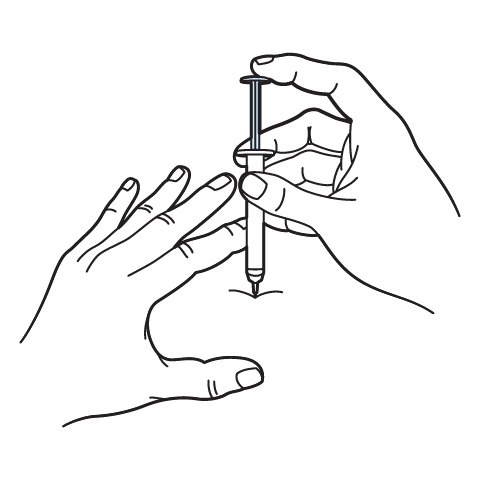
Intramuscular Injection Instructions
503A vs 503B
- 503A pharmacies compound products for specific patients whose prescriptions are sent by their healthcare provider.
- 503B outsourcing facilities compound products on a larger scale (bulk amounts) for healthcare providers to have on hand and administer to patients in their offices.
Frequently asked questions
Our team of experts has the answers you're looking for.
A clinical pharmacist cannot recommend a specific doctor. Because we are licensed in all 50 states*, we can accept prescriptions from many licensed prescribers if the prescription is written within their scope of practice and with a valid patient-practitioner relationship.
*Licensing is subject to change.
Each injectable IV product will have the osmolarity listed on the label located on the vial.

Given the vastness and uniqueness of individualized compounded formulations, it is impossible to list every potential compound we offer. To inquire if we currently carry or can compound your prescription, please fill out the form located on our Contact page or call us at (877) 562-8577.
We source all our medications and active pharmaceutical ingredients from FDA-registered suppliers and manufacturers.

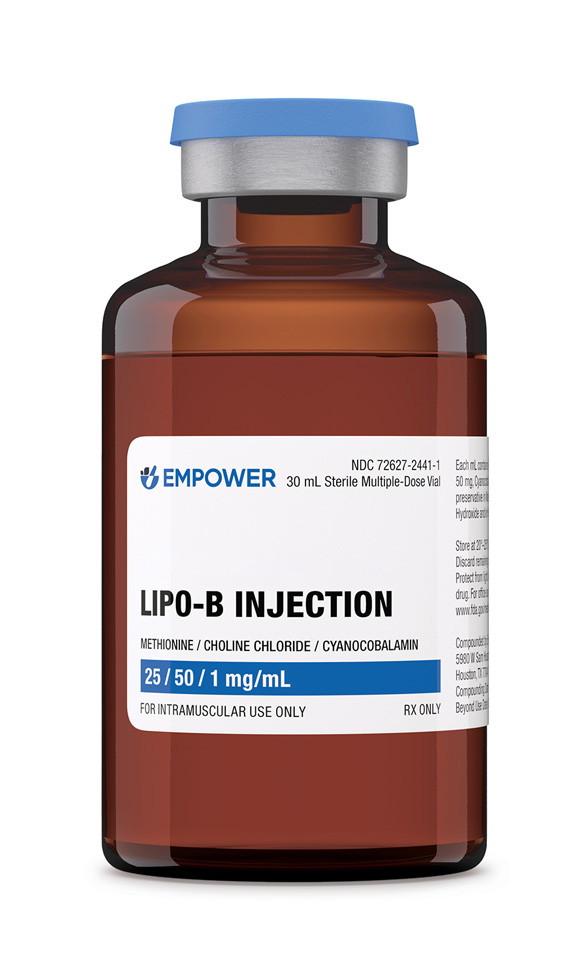
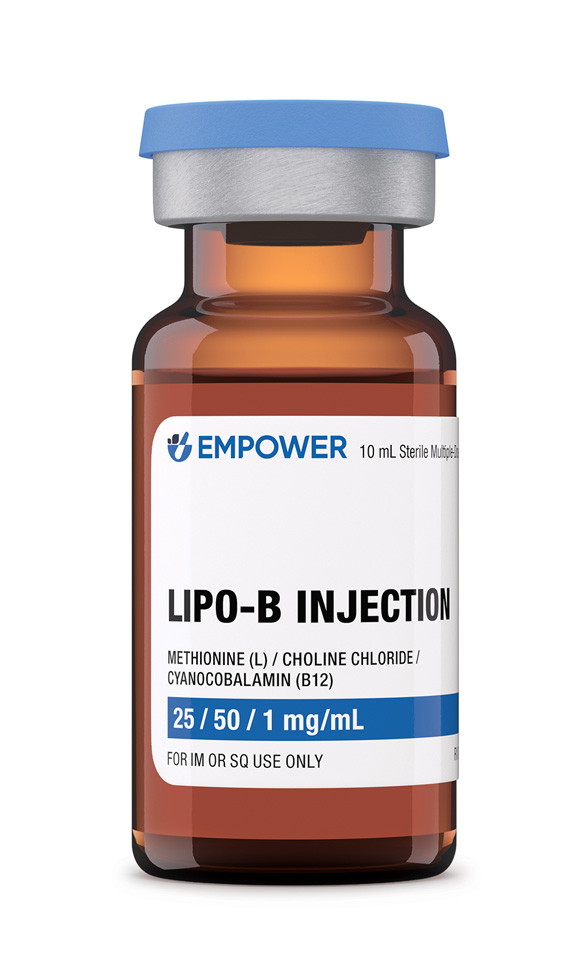
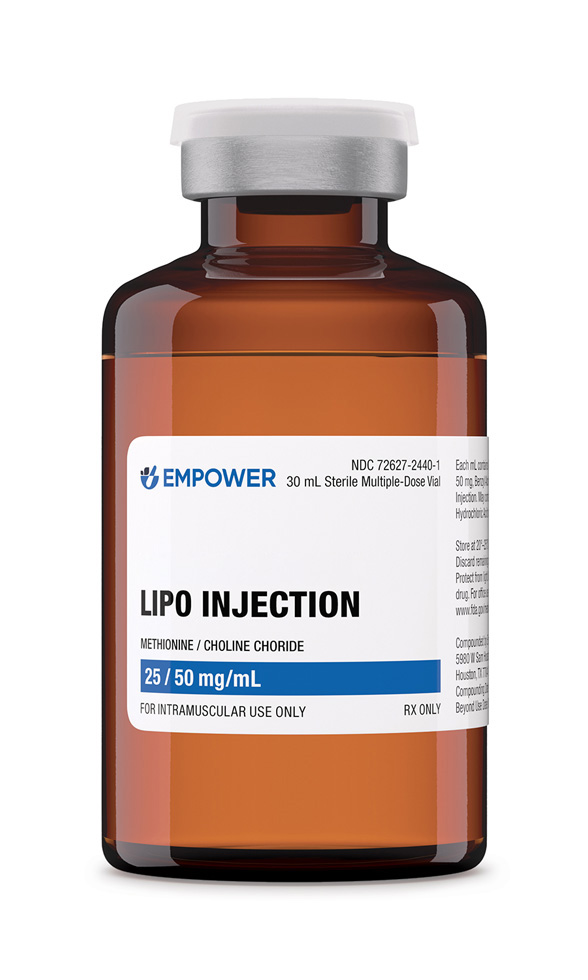 Lipo Injection
Lipo Injection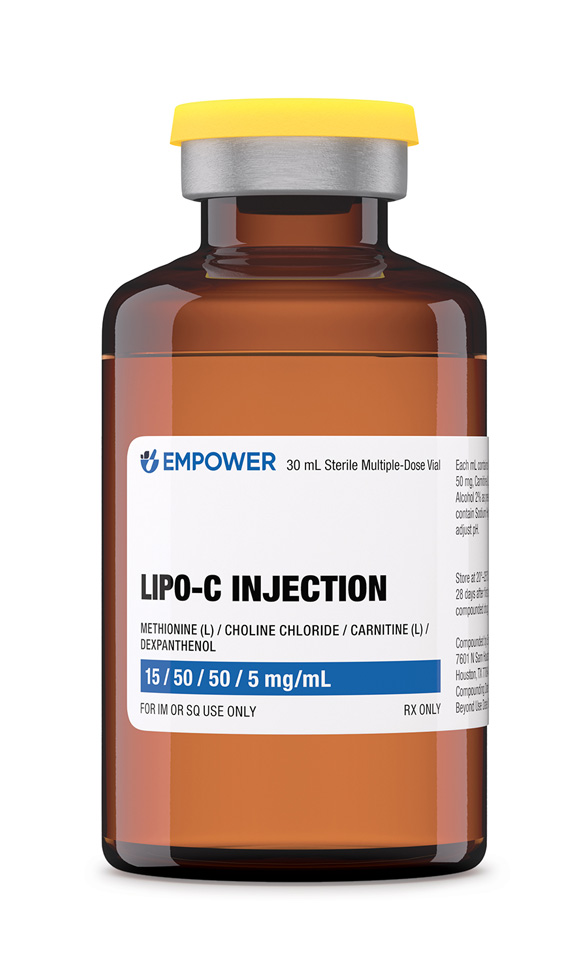 Lipo-C Injection
Lipo-C Injection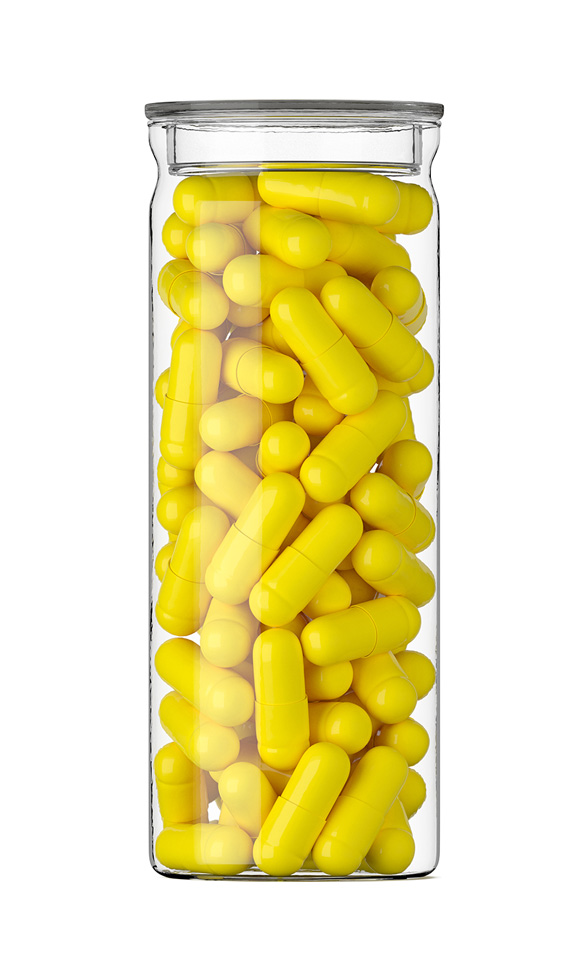 Lipo Burn Capsules
Lipo Burn Capsules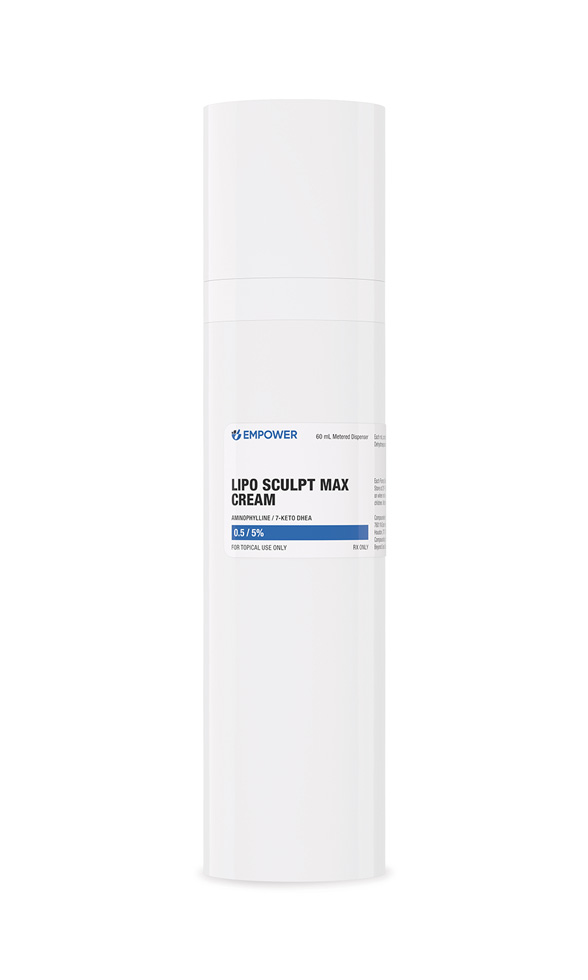 Lipo Sculpt Cream
Lipo Sculpt Cream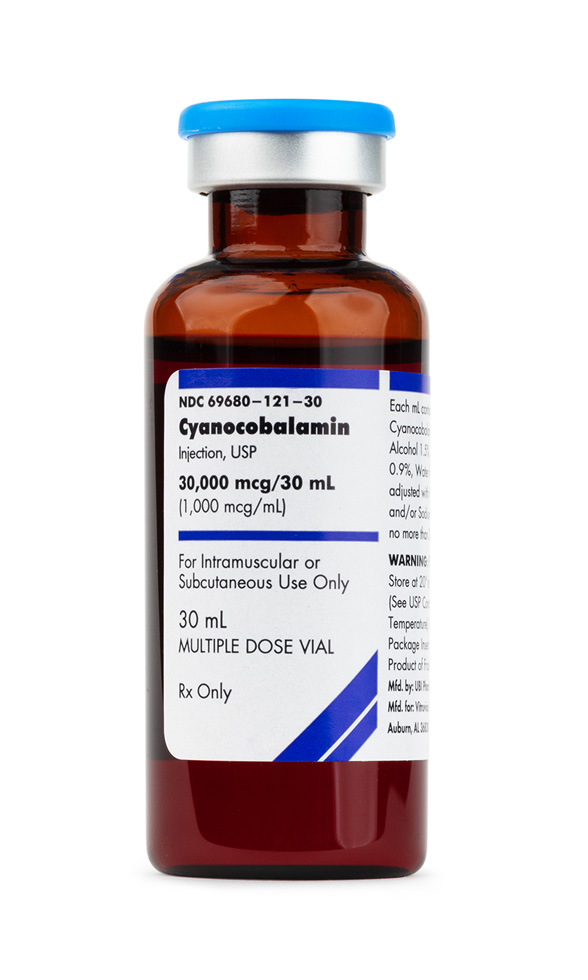 Cyanocobalamin (Vitamin B12) Injection
Cyanocobalamin (Vitamin B12) Injection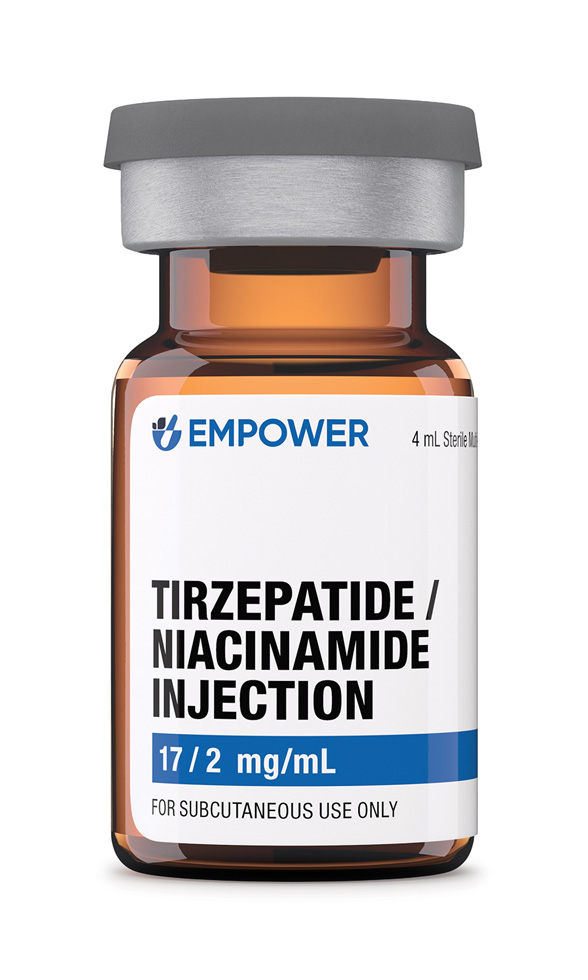 Tirzepatide / Niacinamide Injection
Tirzepatide / Niacinamide Injection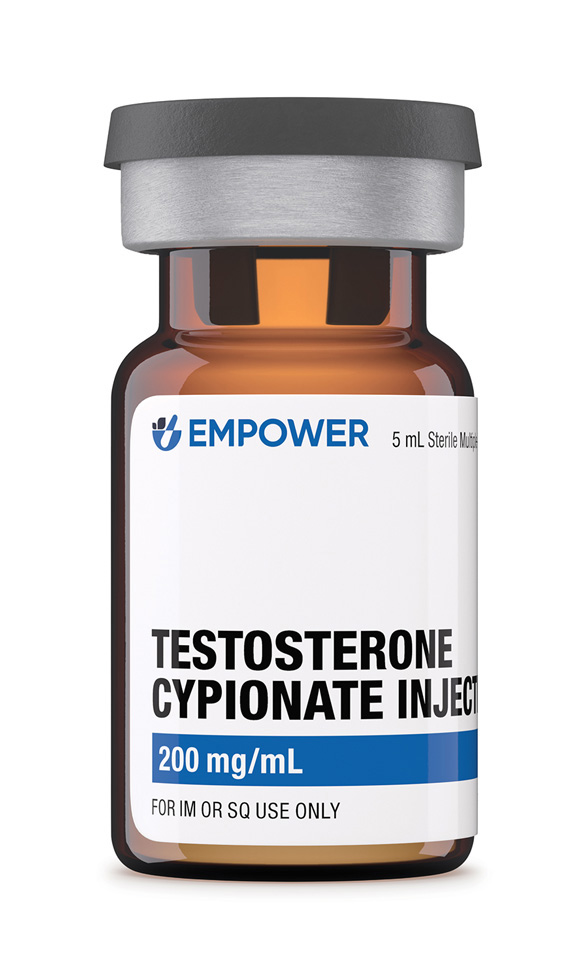 Testosterone Cypionate Injection
Testosterone Cypionate Injection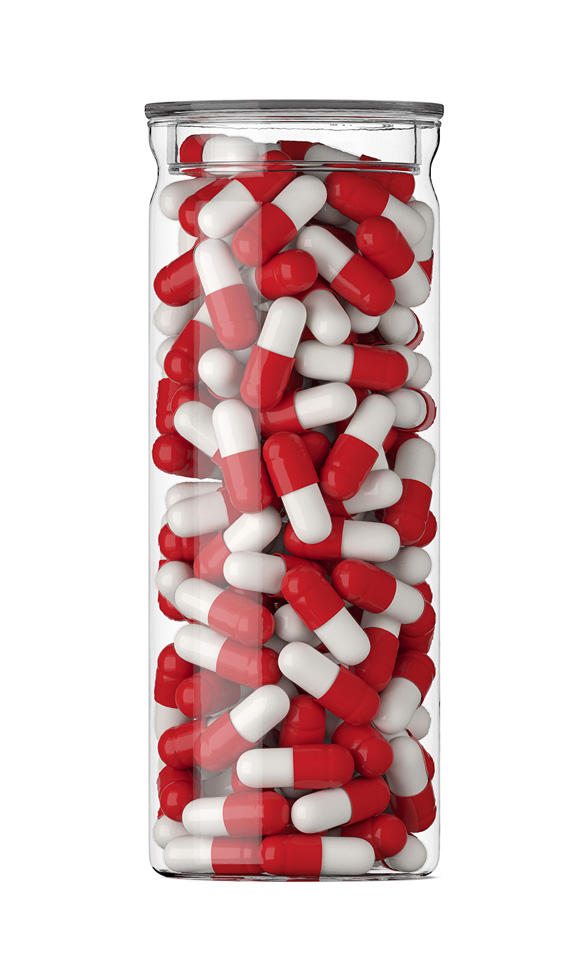 Anastrozole Capsules
Anastrozole Capsules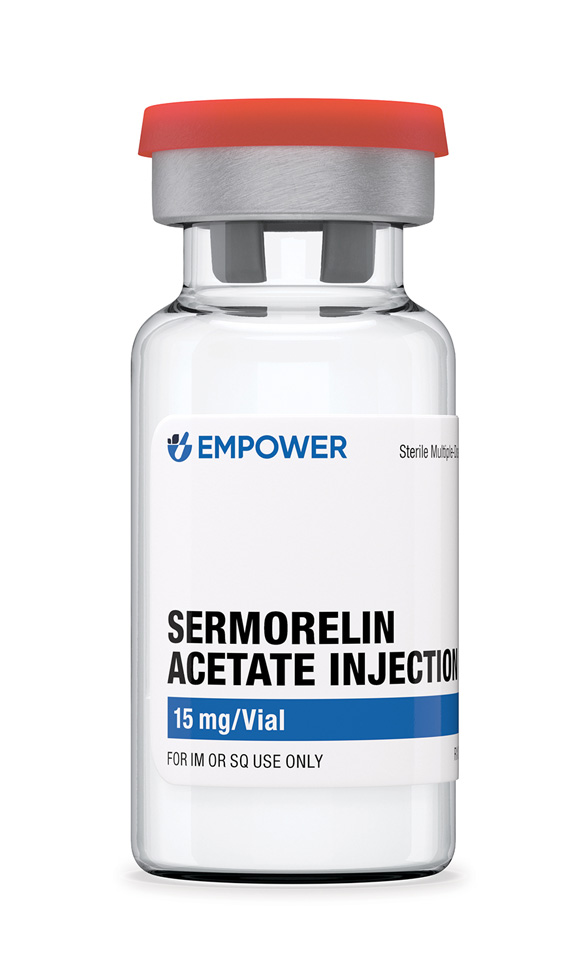 Sermorelin Acetate Injection
Sermorelin Acetate Injection